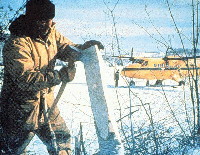Mining in Manitoba
Methods of Prospecting
STAKING A CLAIM

The first concern of a successful prospector is to have reserved for himself the benefits that occur through his efforts and powers of observation and deductions. He is able to do this by the power of the laws that govern and regulate the mineral affairs in the particular jusisdiction concerned.
In most countries, it would appear that the supervision of natural resources is vested in secondary level of government, as in the Provinces of Canada, the States in the United States, and so forth. In general, the intent and spirit of the legislation is directed toward:
- securing to valid persons and companies the exclusive right to pursue development of a discovery
- the protection of the public interest
- the actual encouragement of sub-surface exploration
- providing the means to settle disputes
In Manitoba, staking falls under the Manitoba Mines Act, although the would-be prospector is cautioned that in another Province/State they should study the local legislation.
A mining claim in Manitoba is a square plot of land, measuring about 400 metres (1320 ft.) on a side, with the boundaries oriented in north-south and east-west directions, and containing an area of about 16 hectarces (40 acres). The boundaries are denoted by 4 posts, of which the first, or No. 1, is placed at the Northeast corner, and so on clockwise around the claim to No. 4 at the Northwest corner. The claim lines are also indicated by blazing the trees at intervals or, if the area is treeless, by the setting of suitable pickets. On the No. 1 post at the Northeast corner, the post must be marked with the Staker's name, the number of his licence, the date, and the time staked. The other 3 posts must be marked with his name and licence number.
if a corner of a claim is inaccessible, owing for instance to being in a lake, a Witness post is set on the claim line, and this post must indicate the direction and distance to that post to which it is a witness.
Within 31 days, the staker must apply for a recording of the claim, or claims, at the office of the Mining Recorder in the mining district concerned, provide certain information which will identify the location of the claim or claims, and pay a modest fee in respect to each claim. He is then issued a set of metal tags, and must be affixed to the corner post within 6 months (if not already done so). Then the claim is considered to be properly staked.
At this point, the staker is possessor of an exclusive right to proceed with the exploration and development of his claim(s). To keep his rights alive, this includes a requirement that he perform work on his claims totalling 200 man-days per claim over 5 years, beginning with 40 days of the first year. Such work is known as Assessment Work, must be reported and sworn to before the Mining Recorder, and is also subject to check. Failure to perform this work is considered to mean that he wishes to abandon his rights to the claim, in which case is falls open for staking again.
Assessment work may take many forms, and by doing certain kinds such as diamond drilling, geophysical prospecting, and other activity designed to obtain sub-surface conditions, he is in effect allowed to multiply the mani-hours actually expended by certain factors specified in the rules.
The actual legislation is much more complex, but in every detail it is prompted by the spirit of exploration and discovery.